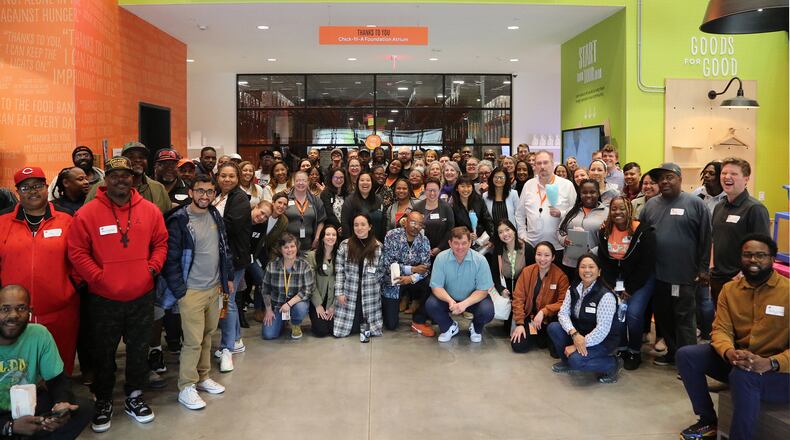As thrilled as Atlanta Community Food Bank (ACFB) president and CEO Kyle Waide is about the incredible milestone of the agency serving its one billionth meal last month, “the job is not finished,” he said. “We want every one of our neighbors to have the food they need when they need it, and have the resources they need to thrive in life.”
“Neighbors” is the word Waide used throughout an interview at ACFB’s campus, where he oversees the distribution of about 100 million pounds of food and grocery products annually. Neighborly help was how Bill Bolling began the organization in the basement of St. Luke’s Episcopal Church in 1979, with his idea of getting more partners involved in feeding the hungry. Now ACFB works through a network of 700 food pantries, community kitchens and nonprofits across 29 counties.
“The food bank has fundamentally been about being a centralized point of acquisition of food and resources in terms of facing the donor community, building a decentralized network of partners, and to really empower them with resources so they can do the work,” Waide said.
Over the years ACFB has dramatically grown capacity as well as radically changed the type of food it provides. “In 2008, 90% of what we were distributing was nonperishable — soup cans and cereal boxes,” Waide said. Today, 44% of the inventory is nonperishable. The 56% of perishable goods include eggs, animal protein and dairy.
In addition, clients have more control over the food they receive. “Instead of just getting a box of food, they’re selecting what they want, which is really important for cultural and health reasons,” Waide said.
ACFB’s services have been in heightened demand since the pandemic. Demand for SNAP benefits increased when the pandemic hit and the food bank helped clients navigate the process. “We had to grow our distribution volume by 70% virtually overnight,” said Waide.
Government aid programs helped the food insecure, but a variety of stimulus programs have since been discontinued. Emergency SNAP allocations (about $95 a month in benefits) ended in Georgia nearly one year ago. The Child Tax Credit, part of the Rescue Plan, also expired. Congress ended the free-lunch-for-all program last June. Along with these discontinuations, food provided to food banks by federal resources also declined.
“To make up the difference, we’re serving the same number of people and providing the same amount of food as we were during the height of pandemic, and we are doing it with less federal food support,” Waide said. In some cases, the food bank buys close to $2 million a month of food.
Credit: Handout
Credit: Handout
With a decrease in government aid programs and the rising cost of food due to inflation, food bank lines are getting longer. There are now about 200,000 households accessing food from the ACFB network each month. “The total population in our 29 counties is a little more than six million and the average household size of people coming to see us is about three,” he said. “So, we are serving 600,000 a month, 10% of the population, which is crazy to think about, and that’s 40% higher than what it was 15 months ago.”
How does ACFB define a food bank “meal”? “When we talk about meals, we’re talking the equivalent of a meal based on estimating the volume of food and how many people that food feeds,” Waide said. That one billionth meal could have been enjoyed at a senior center, a school cafeteria, a community pantry, healthcare center or a mission.
“The majority of people who get food from the food bank are working families, dominantly a single parent household with a couple of kids,” he said. While a billion meals is an accomplishment to be celebrated, at ACFB “we want to continue to be great at playing an advocacy role and continue to inspire the public and private sector so we can make food access more convenient, frequent, consistent and equitable.”
Food insecurity is more than not having enough food. “If you think about the challenges families face,” said Waide, “not having enough food starts a cycle of tradeoffs and compromises families must deal with. Skipping meals or eating less nutritionally leads to chronic health conditions, which in turn leads to medications and doctor visits, which translates to lost time, employment and income.
“We want to cut food insecurity significantly over the next decade,” he said. “We want every one of our neighbors to have the food they need when they need it and the resources they need to thrive in life .”
Visit acfb.org to make a financial donation or get involved as a volunteer.
About the Author
Keep Reading
The Latest
Featured



